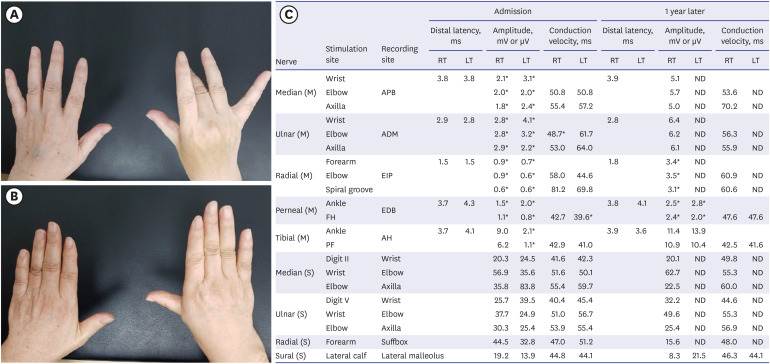J Korean Med Sci.
2022 May;37(20):e160. 10.3346/jkms.2022.37.e160.
Finger Drop-Dominant Variant of Guillain-Barre Syndrome in a Patient With COVID-19: A Case Report
- Affiliations
-
- 1Department of Neurology, School of Medicine, Kyungpook National University, Kyungpook National University Chilgok Hospital, Daegu, Korea
- 2Department of Neurology, Dongsan Medical Center, Keimyung University School of Medicine, Daegu, Korea
- KMID: 2530104
- DOI: http://doi.org/10.3346/jkms.2022.37.e160
Abstract
- Coronavirus disease 2019 (COVID-19) is an infectious disease caused by severe acute respiratory syndrome coronavirus 2 that may trigger Guillain-Barre syndrome (GBS) in selected patients. We describe a case of GBS presenting as marked finger extensor weakness in a 73-year-old woman with COVID-19. Her clinical and electrophysiological findings were consistent with a diagnosis of acute motor axonal neuropathy subtype of GBS with prominent finger dropping. Treatment with intravenous immunoglobulin for 5 days completely resolved her finger extension weakness after 19 months, although other involved extremities recovered earlier at 3 months. This study highlights that COVID-19-associated GBS can present in various forms aside from the classic variant, even in patients without any COVID-19 symptoms. Therefore, it is important to always consider the diagnosis of GBS in patients with COVID-19.
Keyword
Figure
Cited by 2 articles
-
Letter to the Editor: Finger Extensor Weakness Is Not a Novel Clinical Feature of SARS-CoV-2 Associated Guillain-Barre Syndrome
Josef Finsterer
J Korean Med Sci. 2022;37(27):e223. doi: 10.3346/jkms.2022.37.e223.Letter to the Editor: Finger Extensor Weakness Is Not a Novel Clinical Feature of SARS-CoV-2 Associated Guillain-Barre Syndrome
Josef Finsterer
J Korean Med Sci. 2022;37(27):e223. doi: 10.3346/jkms.2022.37.e223.
Reference
-
1. Yoon BA, Ha DH, Park HT, Kusunoki S, Kuwahara M, Lee JH, et al. Finger drop sign as a new variant of acute motor axonal neuropathy. Muscle Nerve. 2021; 63(3):336–343. PMID: 33217007.2. Finsterer J, Scorza FA. Guillain-Barre syndrome in 220 patients with COVID-19. Egypt J Neurol Psychiat Neurosurg. 2021; 57(1):55.3. Hutchins KL, Jansen JH, Comer AD, Scheer RV, Zahn GS, Capps AE, et al. COVID-19-associated bifacial weakness with paresthesia subtype of Guillain-Barre syndrome. AJNR Am J Neuroradiol. 2020; 41(9):1707–1711. PMID: 32586958.4. Dhamne MC, Benny R, Singh R, Pande A, Agarwal P, Wagh S, et al. Guillian-Barre’ syndrome in patients with SARS-CoV-2: a multicentric study from Maharashtra, India. Ann Indian Acad Neurol. 2021; 24(3):339–346. PMID: 34446994.
- Full Text Links
- Actions
-
Cited
- CITED
-
- Close
- Share
- Similar articles
-
- A Case of Guillain-Barre Syndrome after COVID-19 Vaccination
- Post-infectious basal ganglia encephalitis and axonal variant of Guillain-Barré syndrome after COVID-19 infection: an atypical case report
- Guillain-Barré Syndrome with Atypical Clinical Course after BNT162b2 COVID-19 Vaccination
- An Unusual Case of Pure Motor Variant of Guillain-Barre Syndrome Initially Presenting with Hemiparesis
- MRI Features of Multiple Cranial Neuropathies in Guillain-Barré Syndrome Occurring after COVID-19 Vaccination: A Case Report


